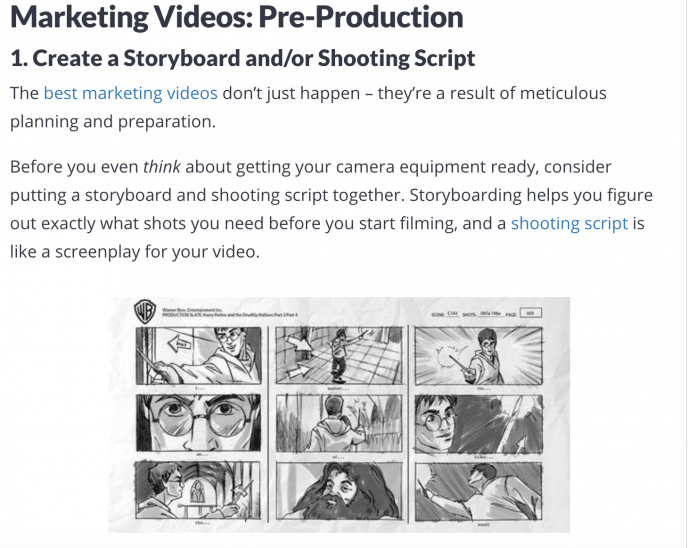Done right, content marketing is a majorly powerful marketing tool for businesses of all sizes across all verticals, but the emphasis is on ‘done right.’
Finding which content marketing strategies work best for you starts with understanding the most essential, tried-and-true content types that other businesses find successful.
Here, we dive into the essential types of content used in content marketing, discuss why they’re essential, and how you can determine if they might be the best fit for your specific business goals and needs, from the top of the funnel to the bottom.
Types of Content Marketing
Now we’re ready to get into the different types of marketing that are most essential to the practice. We’ll go through:
- Blog Posts
- Videos
- Infographics
- Case Studies
- eBooks
- White Papers
- Checklists
- Interviews
- Social Media
- Email Marketing
- GIFs and Memes
- Testimonials and Customer Reviews
- Newsletters
- Podcasts
- Native Advertising
1. Blog Posts
Blog posts truly are a pillar of content marketing, and it’s easy to see why. It doesn’t take much to get started (with resources like WordPress you don’t have to build a blog from scratch and you don’t have to be the world’s best writer), and they are tremendously useful for businesses of all types and sizes.
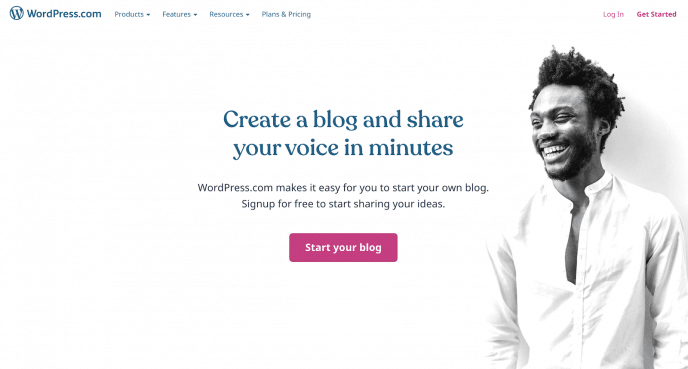
A blog is a place to create content that speaks to your audience and expertise. It’s your space, you can use it however you choose. You can share information, interviews, stories, and more, all hosted in a space of your own.
Plus, blogs are an excellent way to ramp up your SEO (search engine optimization) efforts. According to Forbes, websites that have a blog have 434% more indexed pages (the pages of a website that a search engine has visited), than those that don’t.
Blogs are an essential content marketing type applicable to a wide variety of people and businesses.
2. Videos
Videos have a greater barrier of entry than blog posts, but that barrier is smaller than you think.
Video is a great way to show off your product or service, create an engaging how-to, tell a story, bring an interview to life, and more. Just look at Gary Vaynerchuk’s YouTube channel.
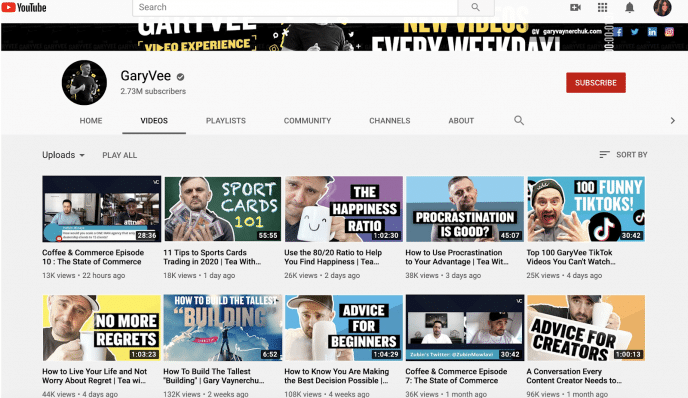
Gary uses video to delve into relevant topics for his audience, interview others, highlight stories, and more.
If GaryVee is more highly produced than you’re able to manage, don’t be intimidated. You can film interviews on conferencing tools like Zoom, or take amazing videos on your phone.
Video may seem like a challenging endeavor, but you can easily remove some common barriers and create great content to meet all types of goals.
4. Infographics
Information is more digestible in the form of an infographic. That’s why this content type lends itself well to data-heavy businesses with a lot of information to share. Assume that your ideal consumer wants to know all of the information you have to share with them, but they want to receive it in a way that’s quick and simple for them to take in.
Here, I’ll tout Taboola’s efforts. When we have a big marketing moment that’s relevant to our audience, like Halloween or Black Friday, and we have an immense amount of data and insights, we turn it into really cool infographics.
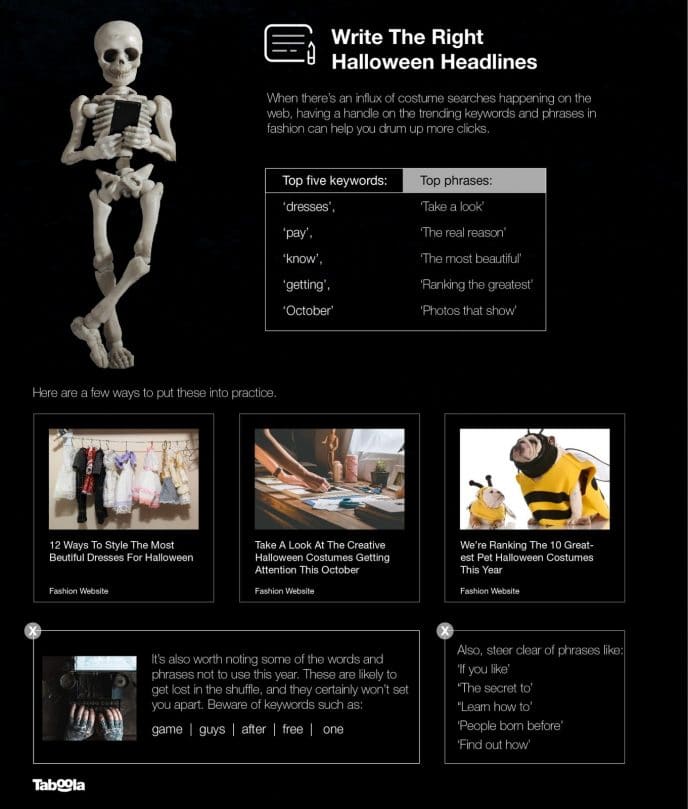
A great deal of work goes into creating infographics – don’t underestimate that – but free tools, such as Canva, let you make infographics on the fly.
5. eBooks
Speaking of a lot of work, eBooks are a heavy lift, but they can have a big return too. According to HubSpot, eBooks are the most popular lead magnet used by marketers, and can establish you as an industry expert.
This content works best when you have a lot of information to share – enough for a whole eBook – and when your audience is open to consuming this type of content.

Salesforce is no stranger to great eBook content. It regularly puts out 10-20 page eBooks full of valuable information in exchange for a potential lead’s name and email.
eBooks are great for delivering value to your audience, collecting leads, and demonstrating expertise.
6. White Papers
Speaking of expertise, white papers are another great way to get that out there. Like eBooks, they’re long-form content, but tend to be denser and more data-driven.
White papers are another lead magnet – all that data and information in return for some basic information about a reader is seen as a fair trade.
White papers are ideal for companies looking to lay out the facts and data, without a ton of flourish and finesse (although that’s not to say white papers can’t have those things, too). They’re also perfect for co-branded studies or efforts.
To compile its wealth of information on how and why schools use its product, DocuSign felt its audience would best be served with a white paper.
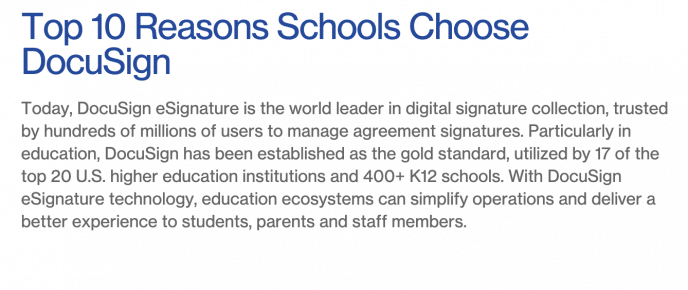
White papers are not for everyone, especially if you don’t have the data to dive into, but when they’re applicable they can be valuable and interesting to consumers.
7. Checklists
Sticking on sharing information or data, but moving away from long-form, checklists are an excellent content tool for getting someone to utilize your product or service.
A simple checklist demonstrates how someone can find success with your product, or get started with your service. It does double duty: it acts as a strong piece of content, and removes any entry barriers to someone choosing to do business with you.
Buffer created three corresponding social media checklists – one daily, one weekly, and one monthly, that make it easy to master social media management best practices.
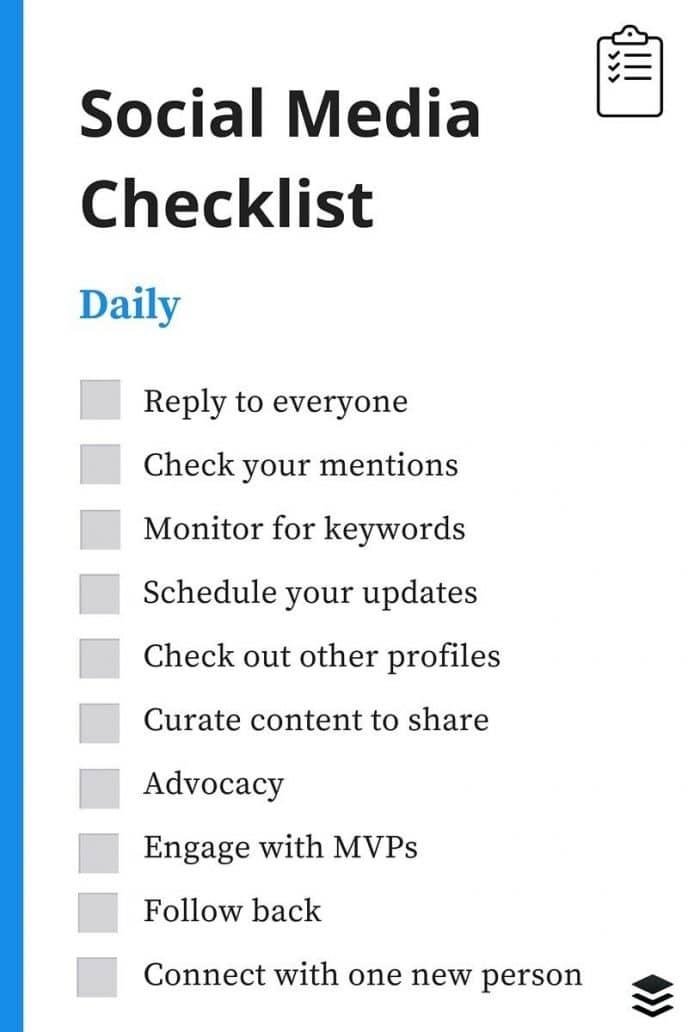
Creating this type of content is great for simplifying processes that your potential customers might find confusing or intimidating, it gives you a chance to show off your branding too. Plus, checklists are very shareable, they get you noticed.
8. Interviews
Interviews are a chance to associate yourself with influential people or companies and get access to their audiences, who may be interested in you too.
Reach out to experts and leaders within your industry – their story could add value to your audience. Own a fashion company? Interview a designer weekly on how they got started. Run marketing for a social media management platform? Talk to social media creators who use the platform to highlight some of their tips and tricks.
Interviews give you a chance to shine and they put the spotlight on a symbiotic relationship between yourself and the interviewee. They’re a win-win, easily created content your audience might find interesting.
9. Social Media
I’m inclined to say this applies to everyone reading this. Having a social media presence is important (it’s often one of the first things someone looks at before deciding whether to do business with you), so creating social media content is important too.
Brands everywhere master social media by creating beautiful, impactful, relevant-for-their-audiences content. Take Dove‘s always-exemplary social presence:
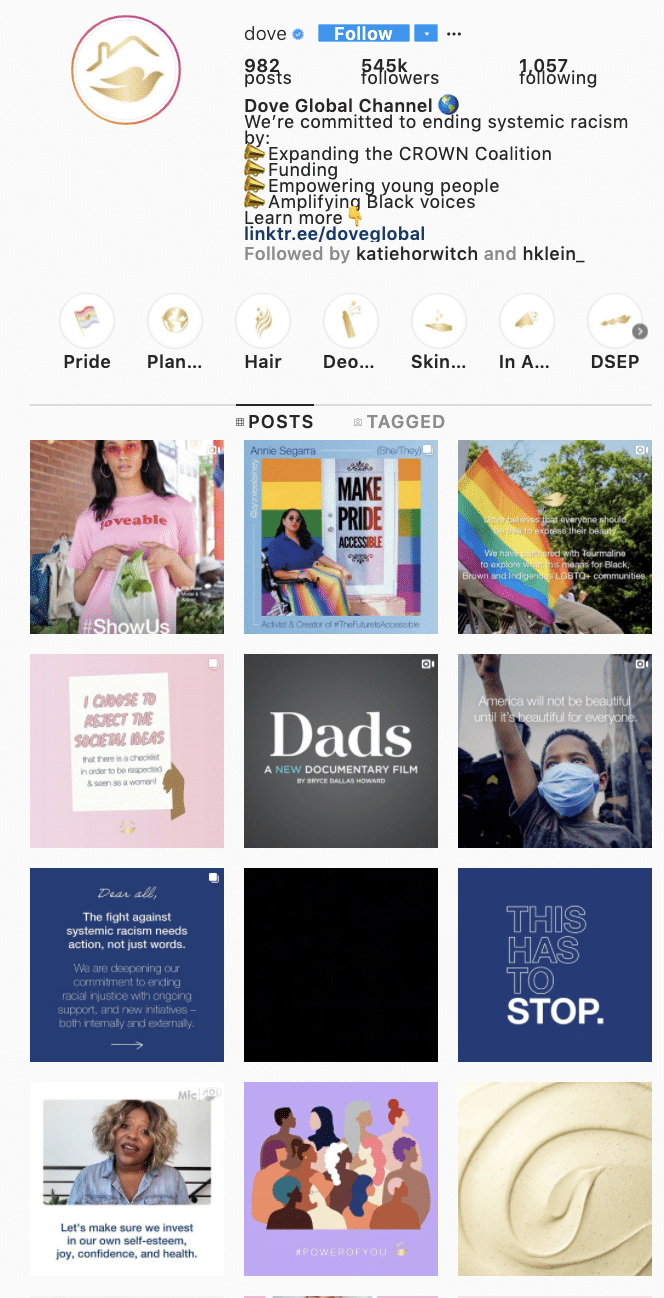
Creating social media is as in-depth a process as you allow it to be, from hiring designers and social media managers to using social media management tools, and more, but having a social media presence is essential for every content marketing strategy.
Find the effort level that matches what you can expend (although it’s worthwhile to consider supplying more resources here), think about the types of content your audience wants and analyze, analyze, analyze based on what performs well.
10. Email Marketing
Email marketing is great for getting and staying in touch with your audience. It also gives you the freedom to find what works best for you, depending on your goals. Companies use it to share product or service updates with their audience, to make announcements, and to communicate with an audience they may otherwise not be able to.
This recent email from Knotch describes an upcoming virtual event, complete with a schedule.
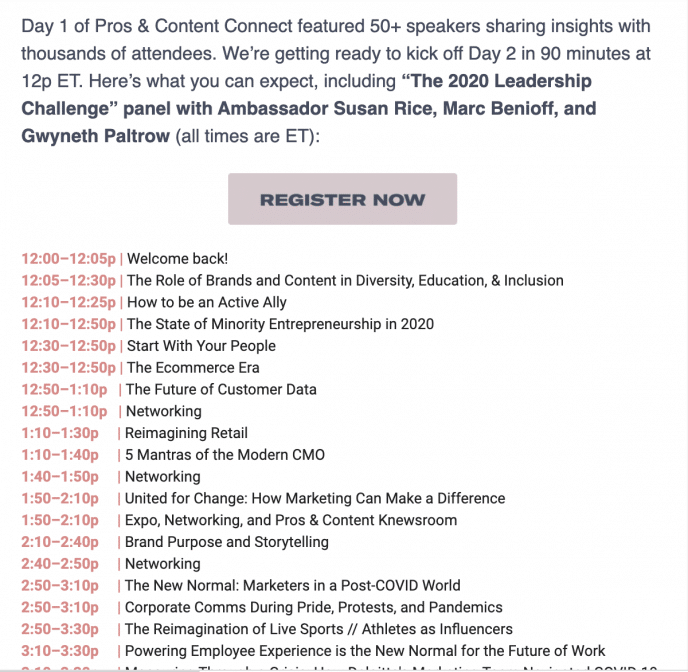
This email is informative and a strong way to get somebody to attend an event – they outline it for you without making you click elsewhere to get information, and the option to register is clear.
Think about some of these elements when you think about email. What might your audience want from you? How can you give them information without making them click around too much? How can you make things clear for them through this correspondence?
Email marketing is a pillar of content marketing, and while automation tools can help, they aren’t required if budget is a barrier.
11. GIFs and Memes
Before you scroll past this one because it doesn’t seem like it’s for you, hear me out! GIFs and memes may not be for everyone, but they may be for you despite you thinking that they’re not.
These days, it’s about being native to the platforms you’re on and not worrying about being overly polished. Memes and GIFs are what people consume on social media, getting in on that conversation makes you look like you belong there.
Tons of companies of all kinds have hopped on the trend, from BarkBox, to Salesforce, to Glassdoor.
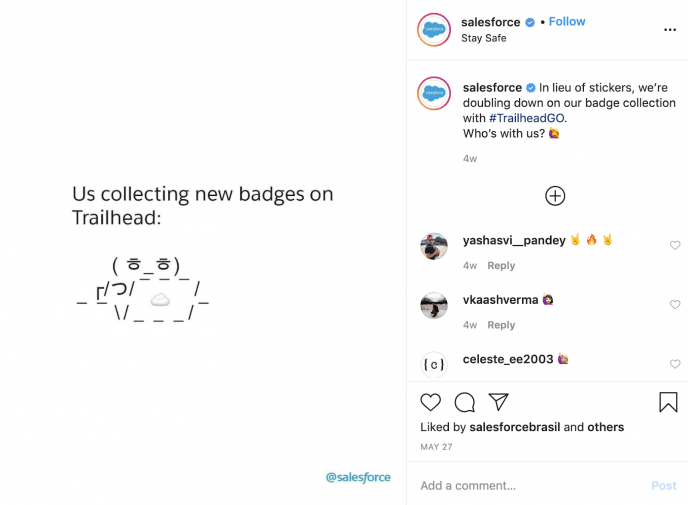
Before you rule out this content, consider the importance of being social media literate, and determine if your audience truly wouldn’t like consuming this type of content, or if getting into it just feels intimidating.
Start small, you don’t need to create a full meme account overnight or even ever.
12. Testimonials and Customer Reviews
Your audience loves you, right? So, shout it from the rooftops. Build a portfolio of testimonials and customer reviews, it might be the content marketing secret sauce you haven’t yet discovered.
Reach out to your customers to get these testimonials or reviews, speak with them, or scan social media and the web for what people are saying about you, and then ask permission to use their words with proper attribution.
Companies use testimonials all the time – so much so, you might barely notice it.
When you obtain an awesome sound bite from a satisfied customer, it is content that you can then turn into another kind of content (a little meta, but follow me here). You can take a great customer quote and design it for your social feed, or include it in a product email. You can even have that customer submit a piece of user-generated content where they speak on video about their experience doing business with you.
Testimonial-based content has a place in the strategy of any business looking to acquire more customers; so, everyone? It’s about building up enough rapport with your audience to get them excited about you sharing their experience.
13. Newsletters
If you’re regularly putting out new products or have a consistent flow of new information you want your audience to know, incorporate a newsletter into your content marketing plan.
Newsletters can be sent on a cadence you feel comfortable with – both from the standpoint of how often customers are receiving communication from you, and how often you think you can put together a fully-fleshed one.
Take eMarketer‘s daily newsletter. It shares a curated list of content and includes a top-line overview to help readers find what’s most relevant for them.
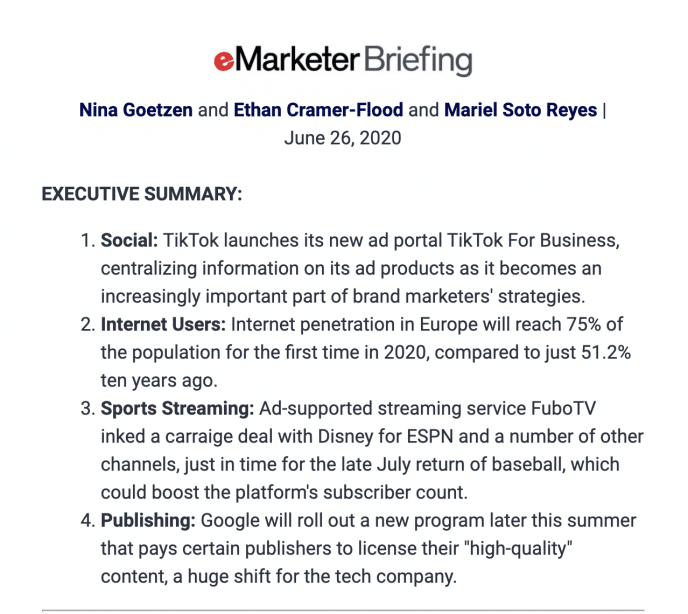
If you don’t have enough to share with your audience daily, make it weekly, bi-weekly, or monthly, but stick with it.
When you launch a newsletter, your audience becomes accustomed to receiving it, so make sure you make the add to their inbox worthwhile.
14. Podcasts
Podcasts are a great example of something that may not be being done in your industry that could give you a leg up. Maybe they are plentiful in your industry (in which case you should still consider one), but if they’re not you have a real opportunity on your hands.
The subject of your podcast gives you a chance to get creative and think about what might add value to your audience. Could this be a good platform to conduct interviews? Could you delve into topics your team members are experts on? Can you share tips relevant to your product or service?
Johnson & Johnson’s podcast,’Innovation,’ examines the latest trends in healthcare. Sumo Logic‘s podcast, ‘Masters of Data,’ shares conversations with people who use data to better the world. Gensler‘s podcast, ‘Gensler Design Exchange,’ is a dialogue between various types of industry experts.
Creating a podcast isn’t easy – it can have its challenges – but if you have a unique idea and think it would add value to your audience, it’s an interesting content type to explore.
15. Native Advertising
Use a content discovery platform, such as Taboola, to implement your content marketing strategy through native advertising.
Native advertisements blend in seamlessly with the content around them, giving you a chance to create content built to drive marketing goals without the common intrusiveness of traditional ad formats.
You can easily repurpose other content you’ve worked on to fit native ad formats, and drive to longer-form content pieces you’ve written.
Why Use Different Types of Content Marketing?
You may ask: ‘Why bother differentiating content marketing efforts? If I find something that works for me, shouldn’t I stick with it?”
I’m not going to tell you not to do something that works for you. You should do something that works for you, but remember, content marketing efforts can get stale fast. Keeping content fresh calls for differentiating from time to time.
Many people associate content marketing with blogging or written articles. These are common, low-barrier-of-entry types of content marketing and they work. There’s a time and a place for other types of content, however, think audio, video, photo-based, interactive, and more.
Consider what best serves your audience in a given situation to figure out when different types of content will work best.
Best Practices to Choose Your Content Marketing Types
Here’s a step-by-step plan for identifying which types of content might work best for you, and when to introduce others:
1. Consider Your Audience
You know your audience better than anyone. Which types of content do they like to consume? Are they on-the-go constantly, rendering them possibly unable to sit down and read? Maybe audio is better for them. Are they social media super-users? Focus your efforts there, then.
Deep diving into your audience personas helps you figure out where and when they might consume content, and it helps make it obvious where you should be inserting your content.
2. Consider Yourself, Too
Your audience comes first, but this is also a time to consider your own strengths. Which types of content can you best create?
Do you have a rockstar writer on your team, even if only by skill and not official job title? Leverage them for written content. Have a skilled photographer on the crew? Maybe they can create clean photo or video-based content.
If you don’t have a skilled videographer onside, is there someone who can learn this skill quickly, follow a guide, and create something?
3. Think About What’s Not Being Done
Does nobody in your vertical do podcasts? Do you feel like your audience might be receptive to these? You may have found yourself a way to use content marketing to stand out.
Look at what your competitors are doing, but more importantly focus on what they aren’t doing. You have a chance to set yourself apart by filling a gap and content can be a really effective way to do this.
4. Introduce Other Types of Content Thoughtfully
It’s important to keep things fresh. Try gradually incorporating other types of content into the content that works for you. If your blog posts, for example, perform amazingly, try turning them into social assets. Grab a pull quote and design it, or take one of the photos featured in the article and format it for social, or do some snack-sized video interviews for sharing on your feed.
Breaking Down the Content Creation Process
Before discussing the different types of content marketing, let’s first understand the process that goes into creating the content that is, in turn, marketed.
When it comes to content creation, there are four steps to hit on:
- Strategy – Where you plan why you’re creating a specific piece of content and decide which goal it ladders up to.
- Copywriting – The written components that make up your content, the what you want to say, and why.
- Imagery – Where you determine how the piece of content will look and which visual elements you need.
- Distribution – How you share the content you’ve worked hard to create.
Every instance of content marketing begins with a plan, focuses on copy, considers aesthetics, and then moves into the distribution phase.
Ready to Create Content and Market It?
We went over a lot here, but a few takeaways are key to hold with you. There are many ways to go about content marketing. To find what works best for you, consider your audience, consider your resources, and be open to the process of trial and error.
Be interesting, be different, and be sure to always add value – not noise – to your audience’s lives.
There’s a world of content out there waiting for you to get creative and add to. Your audience will thank you.
Further Reading
- 22 Content Marketing Statistics That Every Marketer Must Know
- Top Vital Metrics to Measure Your Content Marketing ROI
- How to Create a Content Marketing Campaign
- What Is Content Optimization (And How to Do It)
